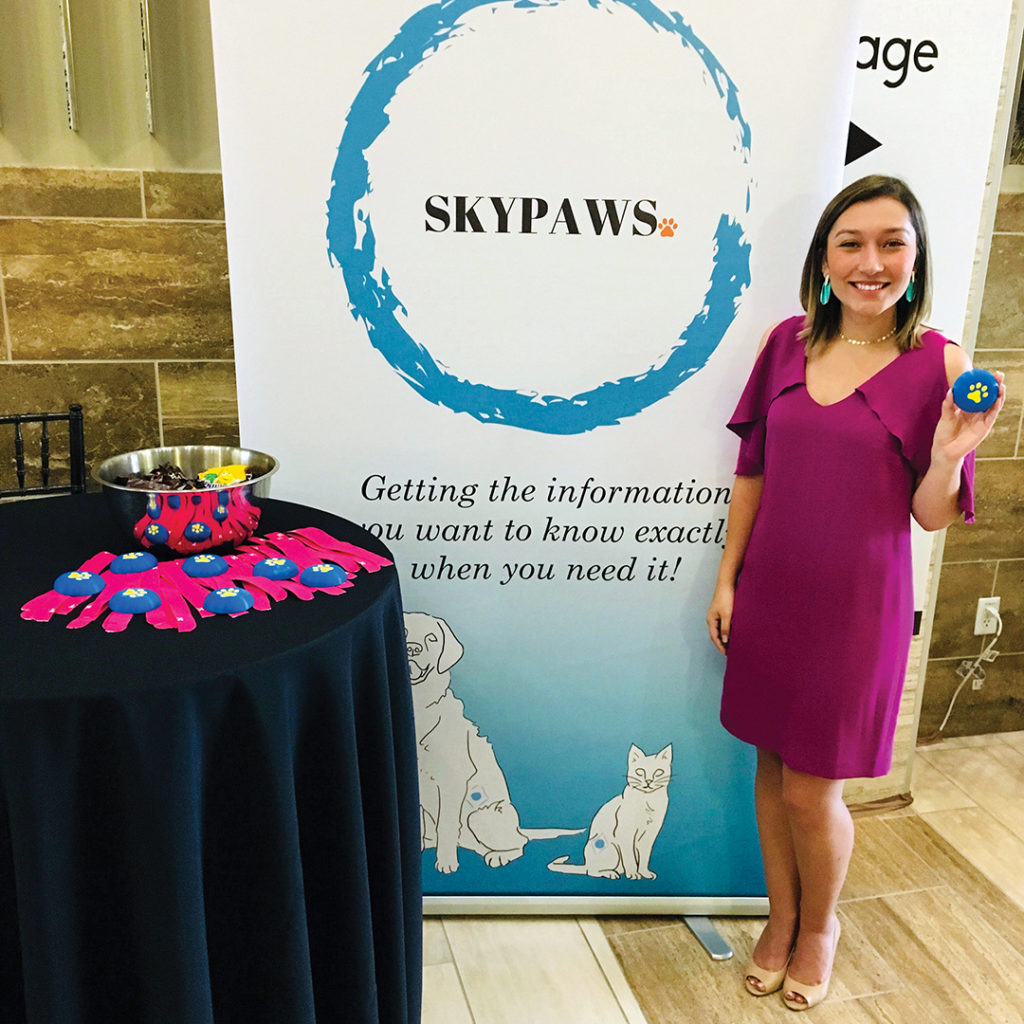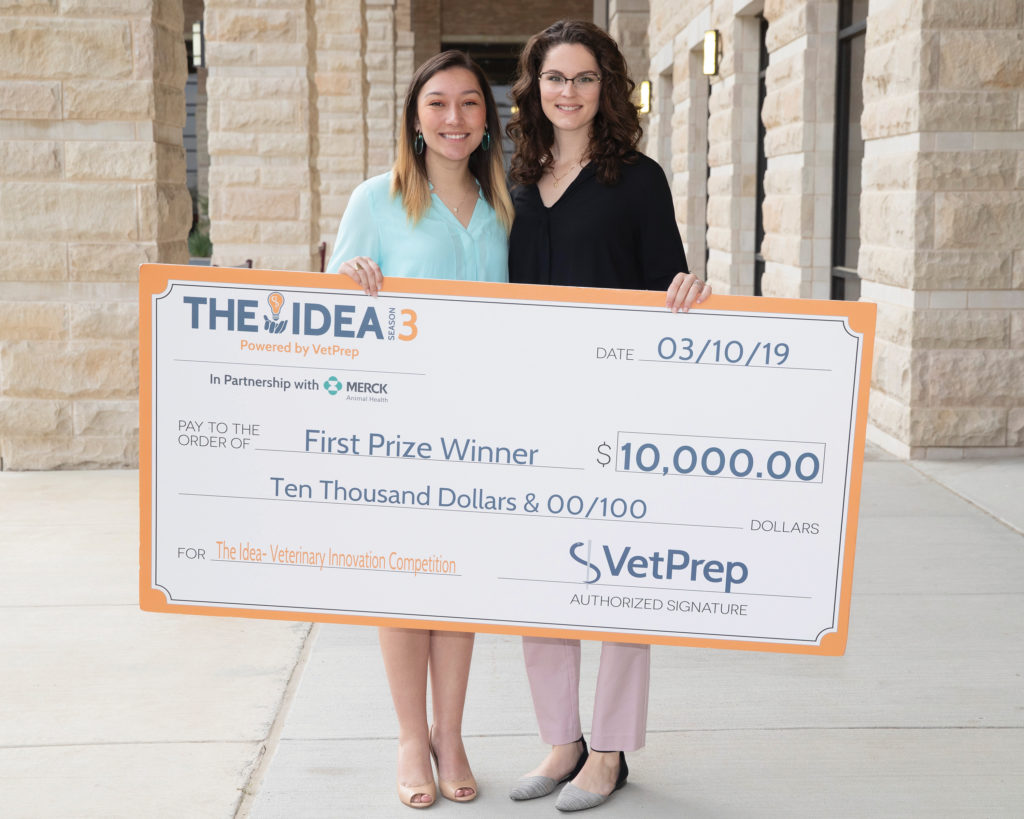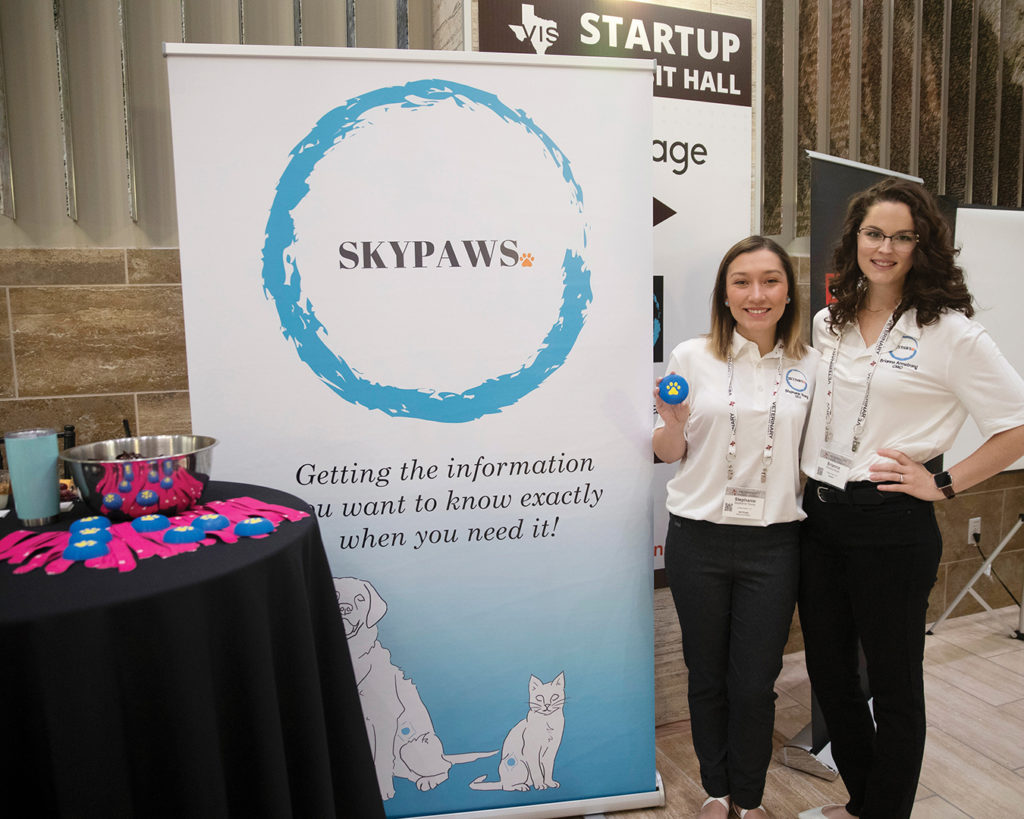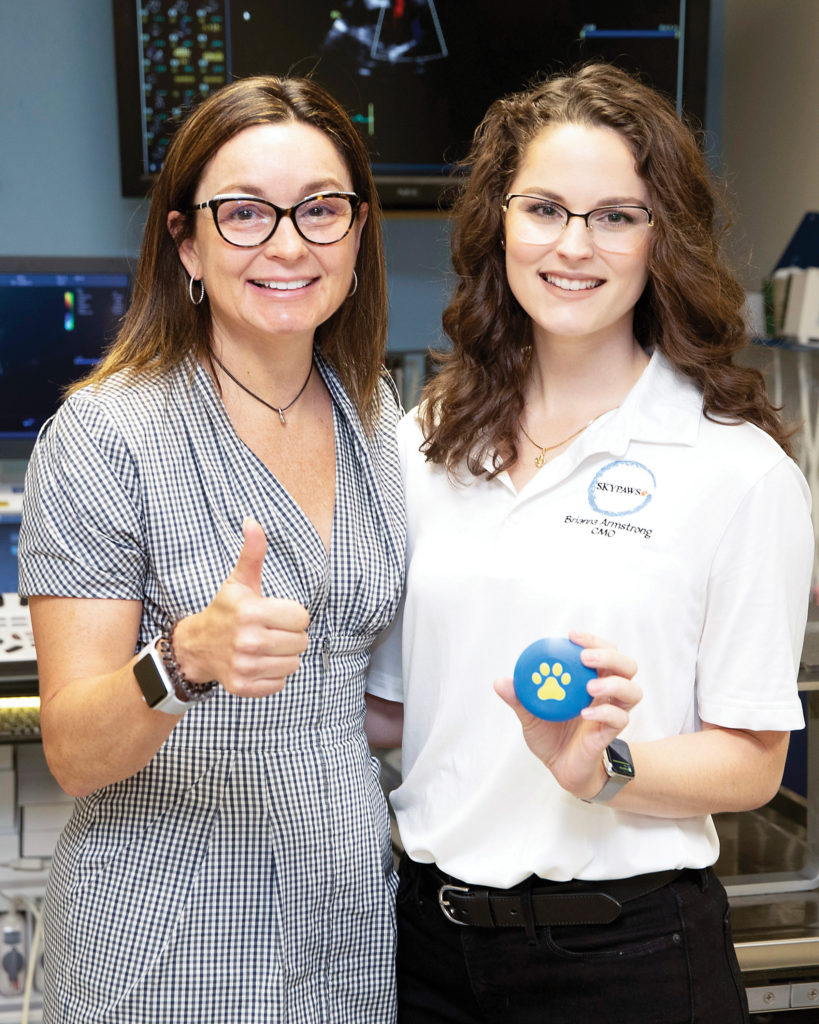Persistence Makes Perfect
Story by Jennifer Gauntt, CVMBS Communications
When Texas A&M veterinary student Brianna Armstrong teamed up with animal science major Stephanie Young, the “SKY” became the limit.

Texas A&M student Stephanie Young’s mantra is “Let them tell me no.”
Perhaps that’s because the one time Young almost took no for an answer, it came from herself.
She had just earned third place in the biomedical engineering division of the state science fair on a project for which she had created a canine-vitals monitoring device.
After the competition, it was suggested that she patent her idea, but being somewhat disappointed in the results, which made her believe people weren’t really interested in a device created by a high schooler, she cut what she saw as her losses and moved on to become an animal science major at Texas A&M, with hopes of becoming an Aggie veterinarian.
Her perspective changed, though, when Dr. Glennon Mays, Texas A&M College of Veterinary Medicine & Biomedical Sciences’ (CVM) director of recruiting and student services, talked to her class one day. Following his talk, she approached Mays and over the course of the conversation, told him about her invention, SKYPaws.
“I didn’t expect to tell him about it. I remember arguing with myself in line. I was like, ‘This is stupid,’” Young recalled thinking. “I don’t know if y’all believe in a higher power, but I believe in God, and I believe He was sitting there telling me, ‘you need to tell him.’”
And so she did.
Mays encouraged Young to participate in the CVM’s Veterinary Entrepreneurship Academy (VEA), a program that brings together veterinary students, academic institutions, startup partners, and veterinary practices from across the country to accelerate animal heath innovation and empower the next generation of veterinary practitioners.
Though not quite a veterinary student, she was offered the opportunity to participate in the VEA last summer. Through that experience, she found both encouragement and the person who would become her partner—third-year veterinary student (at the time) Brianna Armstrong; she also began to reevaluate the internal “no” she had given herself regarding SKYPaws.
Bringing Armstrong On Board

Early iterations of SKYPaws (now, formally, SKYPaws, LLC), named after Young’s initials, included a clip that connected to the webbing between the toes on an animal’s paw.
When Armstrong came on board, the pair began refining the device, and the patent-pending version now allows veterinarians to monitor their patients’ heart rates, respiration, temperatures, and other vital signs by lying the sensor against the animals’ skin.
“SKYPaws eliminates the wires and condenses all of the sensors down into one device. This creates less hassle for the veterinarian and the technician, and it allows for remote, instant access to your patients’ vitals,” Armstrong said. “The vitals are live-streamed across our website or application, which can be accessed anywhere within the facility by the veterinarian, so they don’t have to be patient-side in order to see what’s going on with the patient’s vitals.”
The idea for SKYPaws stemmed from an experience Young had while working at the College Avenue Animal Clinic in her hometown of Levelland, Texas.
During one shift, a dog named Charlie underwent a routine surgical procedure. The surgery went well, without any complications, so the hospital staff called Charlie’s owner to inform her that she could pick him up at the end of the day. Before that could happen, though, Charlie died.
“The veterinary hospital was so busy that day, and his vitals were fine, so we put Charlie in the kennel and decided to check on him every once in a while to make sure that he was doing OK,” Young said. “Not five minutes later, I was mopping the facility and I happened to walk by and notice that Charlie was unusually still. Knowing that something was off, I called the veterinary technician over, and Charlie wasn’t breathing. At that moment, the whole clinic flew into a frenzy. They did everything they could, but, sadly, Charlie didn’t make it.
“One of the hardest things was talking to the owner, saying that her dog Charlie, who was going to go home to her family and had been doing just fine, wasn’t,” Young said. “That whole time, I was wondering if there was a way that we could monitor these patients better, without just leaving them in the kennel and hoping that they’re still breathing.

“SKYPaws was born that day,” she said.
When the VEA renewed her enthusiasm for the project, Young began exploring fundraising opportunities; while attending a conference, she came across an ideas competition that paid a top prize of $10,000—the caveat, however, was that only veterinary students could apply for the competition.
Seeking out advice, she went to VEA mentor Dr. Aaron Wallace, co-founder of Lacuna Diagnostics, who was also at the conference.
“I went over to his booth and told him I wanted to apply for this ideas competition but it says in big, bold letters, ‘For Vet School Students Only,’” Young said. “Dr. Wallace goes, ‘Stephanie, you’re in the VEA, and that’s for vet school students only. Let them tell you no, because that’s the worst that could happen.”
With just three days before the application deadline, Young gave it a shot and asked Armstrong to join the team.
“When Stephanie came to me with her idea and was asking me if I would be interested in being a part of SKYPaws in the competition I thought, why not? Because, one, I really love entrepreneurship and, two, I would now have a partner who can help me get this going,” Armstrong said. “It ended up working out really well; we’re great partners in that we kind of balance each other out, as far as personality types go, so it ended up being a really great partnership.”
The pair spent the next eight months engrossed in preparation—constructing a prototype, creating a business plan and countless videos to explain the product, completing market research that included interviewing veterinarians, and developing and refining their pitch.
This past March, they traveled to Athens, Georgia, for the contest and won. Since then, they’ve also won an additional $10,000 at the Veterinary Innovation Summit’s startup competition.
Reaching For The ‘Sky’

Almost better than the money is the validation the pair has received for their product.
“The feedback we have received is that SKYPaws is incredible, it’s where the industry is going, and that people love our passion and hope we are the ones to do it first,” Armstrong said. “It’s just been really positive and really uplifting to see that what we’re doing, what we believe in, so many other people also believe in. That’s always a really good feeling.”
A number of practicing veterinarians with whom Armstrong and Young have talked about SKYPaws have expressed interest in helping test the prototypes once they’re created, including Dr. Sonya Gordon, a cardiologist in the CVM’s Small Animal Hospital.
“The development of this kind of device, that is small and easy to use, will facilitate the diagnosis and management of heart failure in companion animals,” Gordon said. “An all-in device that can provide longitudinal information from pets in their home environment with minimal stress would play an important role in managing a variety of diseases, both clinically and in research studies, and also as a monitoring tool in hospital situations.”
As Armstrong completes her fourth-year clinical rotations and Young her junior year, the pair will keep looking for the next “yes” that will help them make their dream a reality.
“We hope to hit market within three years. A lot of people want us to hit market a lot sooner than that, and I think with the appropriate funding, we might be able to. We’re currently working with engineers who are students, and we’ll definitely have a device within a year that we’ll put in the hands of some veterinarians to start testing,” Armstrong said. “So, I’m being cautious and saying I think in three years we might be ready.”
For more information on SKYPaws, visit www.skypawsdevice.com.
###
Note: This story originally appeared in the Fall 2019 edition of CVMBS Today.
For more information about the Texas A&M College of Veterinary Medicine & Biomedical Sciences, please visit our website at vetmed.tamu.edu or join us on Facebook, Instagram, and Twitter.
Contact Information: Jennifer Gauntt, Director of CVMBS Communications, Texas A&M College of Veterinary Medicine & Biomedical Sciences; jgauntt@cvm.tamu.edu; 979-862-4216



